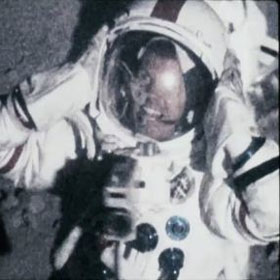Apollo 18

3/5
The thing about the so-called “found footage” sub-genre of horror is that you invariably know where the story is going before you begin. It’s not called the “willfully-submitted-after-being-rescued-alive-and-well footage” sub-genre after all. While variations of the trick date back as far as the 1950’s, it didn’t really take off commercially until 1999, when Daniel Myrick and Eduardo Sahcnez thought up the seminal gimmick of using this newfangled Internet thing to concoct an elaborate back-story, suggesting that the handy cam scurried screaming of three wannabes taken in the autumnal woods of Maryland was genuine. Since then the idea has been to subtly imply the worst – that the individuals who captured these spooky goings on did not ultimately survive them.
Nowadays, however, the cat’s out of the bag. So, if you’re embarking on such an endeavor you better make damn sure that whatever you’ve concocted packs enough of a visceral punch to give the audience more to think about that just their headache. While Apollo 18 falls well short of greatness, this lunar-based creature feature has more than enough about it to ensure that it is worthy of your time. Fledgling filmmaker Gonzalo Lopez-Gallego is clearly working very hard for his audience. Seamlessly blending NASA stock footage with grainy, Super 8mm home video of backyard barbecues and cowboy-clad nippers this Spanish helmer readily evokes a tantalizing aroma of by-gone Americana.
Apollo 18 is a post-modern horror film that knows the value of history. It’s a conspiracy theory set against the backdrop of a tumultuous period of the nation’s history, where the can-do era of the space race gave way to Watergate and a broken-hearted distrust of those in power. As Commander Nathan (“Nate”) Walker and Captain Benjamin (“Ben”) Anderson, respectively, actors Lloyd Owen and Warren Christie exude just the right amount of square-jawed good-ole-boy-ness, tempered with a knowing sense that this classified NASA-CIA co-sponsored moon landing marks them both in the file labeled “expendable.”
Even at a brisk 86 minutes the picture does take a little while to settle. The chop-chop nature of the opening – blending newsreel, home-movie, and talking head confessional, combined with a sound design built around hums, clicks, and whirs that simply never ends – is more likely to illicit a sense of nausea from the viewer than imbue much in the way of anticipation. It’s not until we touch down that the film finds its groove.
Watching these guys scuttling around the cramped, cluttered, tin can that is the landing module, surrounded by an endless see of grey rocksand and silent darkness, a queasy claustrophobia sets in. Unlike the gaping plotholes of, say, Paranormal Activity (hey, why not just get out of the house?), Apollo 18 offers no such easy escape. These guys have literally nowhere to run. With the pieces finally in place Gallego still manages to take his time, somewhat, with a slew of suggestive possibilities and potential red herrings that fit well with burgeoning paranoia of the time; are the Russians already here? Does the Agency know more than they’re letting on? Is the real danger without, or within?
While the production design is flawless, and the performances suitably understated, occasionally the director’s inexperience serves to undermine his larger efforts. A too-clever-by-half trick of illuminating a pitch-black crater by bursting strobe is obvious in it’s intention, gimmicky, and repeated once too often, while the ultimate reveal of just what exactly these guys have awakened up there is underwhelming to say the least. Although it might put you off seafood for a little while. In the end that is Apollo 18's downfall; that it is too eager to do the legwork and in making the entity so definitive the picture robs itself of its greatest ally – the viewers own worst nightmares sloshing around inside their heads
But those failings aside, Apollo 18 is a commendable genre entry that is at the very least about something. What it does accomplish is achieved through a sustained mood and expertly crafted aesthetic; posessed of an eerie beauty and – after a nervy open – effective use of silence, rather than simply beating the viewer over the head endlessly with a “one-louder” setting for all the scary bits that has been lazily added in post, which is so often the go-to crutch for this sort of thing.
RELATED ARTICLES
Get the most-revealing celebrity conversations with the uInterview podcast!







Leave a comment